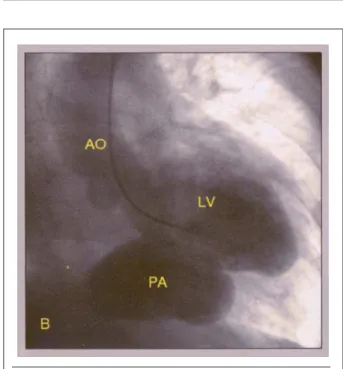Case Report
Key words
Aneurysm, false; heart ventricles; left ventricle.
Left ventricular free wall rupture is a dramatic but not always fatal complication from myocardial acute infarction. However, if proper diagnosis is delayed, surgical treatment may be compromised. The authors report a case of large pseudoaneurysm in left ventricular inferior wall diagnosed on angiography study.
Pseudoaneurysm of Left Ventricle
José Luiz Balthazar Jacob, Graziele Buzelli, Nilton Carlos Spinola Machado, Pedro G. A. Garzon, Sérgio A. C. Garzon
Instituto de Moléstias Cardiovasculares - IMC - São José do Rio Preto, SP - BrazilMailing address: José Luiz Balthazar Jacob •
Rua Castelo D’Água, 3030 - 15015-210 - São José do Rio Preto, SP - Brazil E-mail: jljacob@cardiol.br
Manuscript received August 15, 2006; revised received February 12, 2007; accepted March 13, 2007.
Case Report
A 67-year-old female non-diabetic patient with an angina condition and no previous infarction was submitted to non-pharmacological stent implant in anterior descending and right coronary arteries. Both arteries showed diffuse parietal infiltrations, but no other significant stenoses in addition to those already treated.
Three months after percutaneous treatment the patient was admitted at another cardiology service unit with repetitive chest pain that developed to persistent pain and then to acute myocardial infarction with relevant pulmonary congestion.
Due to inadequate response from clinical treatment, the patient was transferred to our Tertiary Cardiology Center for cinecoronariography after 72 hours. The patient presented dyspnea and disseminated stertors in both pulmonary bases. A mild, holosystolic murmur could be heard on left lower sternal border. Acute myocardial infarction was shown on ECG at diaphragmatic wall, already presenting Q waves. Patient’s medical records did no include previous ECG or MRI images. Emergency cinecoronariography was performed and showed significant in-stent restenosis of right coronary artery (Figure 1-A), in-stent restenosis in anterior descending artery and occlusion of posterior descending branch of right coronary artery. Left cineangioventriculography showed a large pseudoaneurysm of the inferior wall (Figure 1-B) and mild mitral valve regurgitation.
Due to clinical instability, emergency surgical treatment was attempted, but pseudoaneurysm rupture on anesthetic induction led to cardiac tamponage. Cardiac tamponage was treated with open thoracic drainage. Ventricular wall rupture compression was performed with fingers while extracorporeal circulation was established.
Fig. 1-A - Selective injection in right coronary artery (RCA) showing significant in-stent restenosis (arrow), short coronary distal branches, and occlusion of posterior descending branch of right coronary artery.
Fig. 1-B - Left cineangioventriculography (LV) showing large pseudoaneurysm (PA) of left ventricular inferior wall. AO - aorta.
Left ventricular wall rupture was sutured and repaired with bovine pericardial patch. A saphenous vein graft for
Case Report
Jacob et al Pseudoaneurysm of left ventricleArq Bras Cardiol 2007; 89(1) : e1-e2
anterior descending coronary artery was performed. Despite all diligence, the patient died from irreversible cardiac arrest at extracorporeal circulation outlet line.
Discussion
Left ventricular pseudoaneurysm is quite a rare complication following acute myocardial infarction or heart surgery. It results from ventricular wall rupture with no cardiac tamponage. Free wall rupture is contained by perdicarcial ahesions, thus producing the pseudoaneurysm. Due to the risk of rupture (30% to 45%) and death, surgical treatment is recommended when left ventricular pseudoaneurysm is detected1-3. Most commonly diagnosis is reached at
pseudoaneurysm chronic stage, which may go on for years with no rupture1. However, a significant number of patients
that develop left ventricle pseudoaneurysm are not diagnosed in the acute stage due to early, fatal rupture3,4. Chronic cases
are usually asymptomatic1.
Non-invasive, imaging diagnostic methods - such as echocardiography or MRI – are useful for the diagnosis of this complication1,2 and should be encouraged, so that more and
more cases can be detected in the acute stage.
Left cineangioventriculography is the most accurate diagnostic method. Associated to cinecoronariography it is key for surgical treatment3 planning, since concurrent mitral valve
dysfunction is a common occurrence, and surgical myocardial revascularization is frequently required. In this specific case report, mild mitral failure resulting from posterior papillary muscle and left ventricle morphologic damage caused by the pseudoaneurysm was not evidence for a congestive condition, which was actually due to left ventricular systolic dysfunction caused by large pseudoaneurysm. Surgical treatment of left ventricular pseudoaneurysm in acute
myocardial infarction reports high mortality rate (23% to 28%)3-5. But the probability of pseudoaneurysm fatal rupture
is higher than surgical risk3,4.
Heart failure and mitral valve dysfunction increase surgical death rates. Although asymptomatic patients treated clinically may present low rupture risk1, high mortality rate (48%) has
been reviewed with clinical treatment.
The incidence of cerebral ischemia (10% within 1 year and 32.5% within 4 years) is a constraint for drug therapy to treat pseudoaneurysm.
In the light of the arguments above, surgery is the choice treatment.
Conclusions
The present case illustrates hemodynamic dysfunction after acute myocardial infarction may be a result of left ventricle pseudoaneurysm which although very rare may have early diagnosis. Angiography studies contribute for correct diagnosis.
Potential Conflict of Interest
No potential conflict of interest relevant to this article was reported.
Sources of Funding
This study was funded with the investigator´s own resources.
Study Association with Graduate Work
This study is not associated with any graduation program.
References
1. Moreno R, Gordillo E, Zamorano J, Almeira C, Rubira JCG, Ortiz AF, et al. Long term outcome of patients with postinfaction left ventricular pseudoaneurysm. Heart. 2003; 89: 1144-6.
2. Ropers D, Achenbach S, Pfeiffer S. Left ventricular pseudoaneurysm following myocardial infarction. Heart. 2004; 90: 555.
3. Frances C, Romero A, Grady D. Left ventricular pseudoaneurysm. J Am Coll
Cardiol. 1998; 32: 557-61.
4. Prête R, Linka A, Jenni R, Turina MI. Surgical treatment of acquired left ventricular pseudoaneurysms. Ann Thorac Surg. 2000; 70: 553-7.
5. Komeda M, David TE. Surgical treatment of postinfarction false aneurysm of the left ventricle. J Thorac Cardiovasc Surg. 1993; 106: 1189-91.
